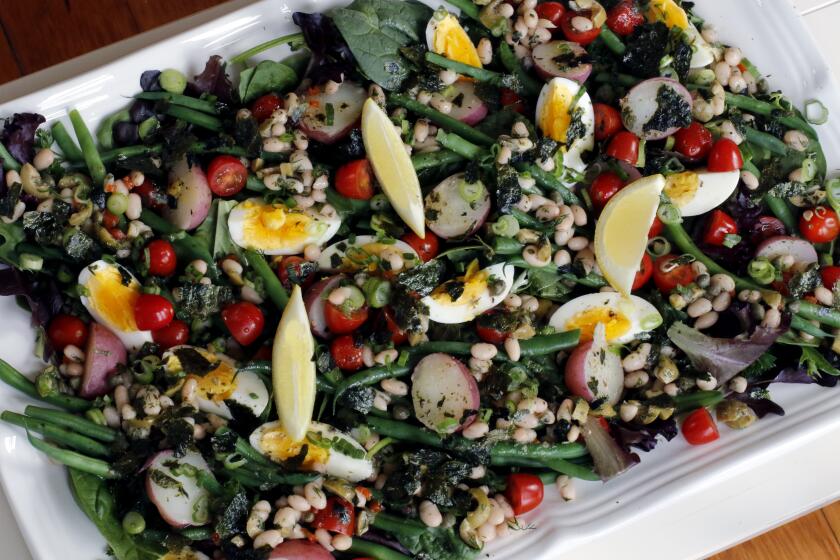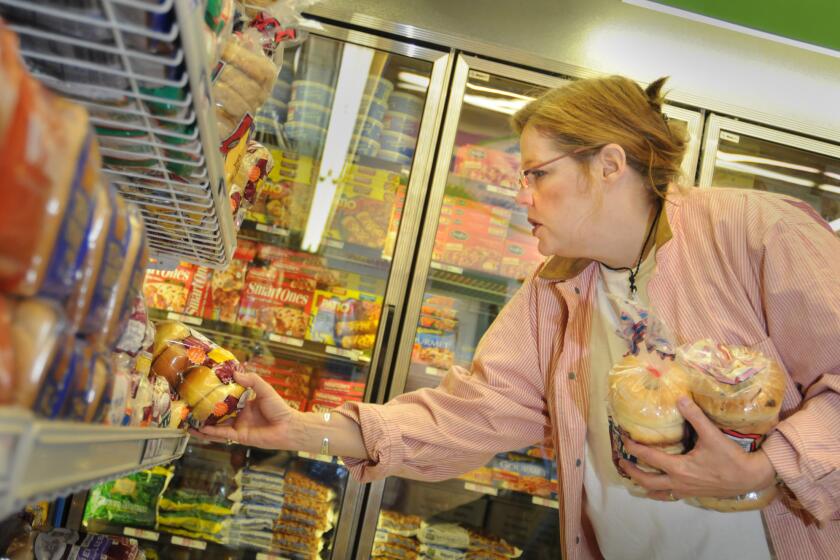What Americans want from food: Energy, muscle strength, better health and less stress

- Share via
What’s for dinner?
It’s a deceptively simple question, asked millions of times each day. But consider the myriad factors that go into answering it — from cost to convenience to climate change — and it’s no wonder we spend so much time thinking about the food we eat.
And that doesn’t even account for breakfast, lunch or snacks.
Quite a lot rides on Americans’ food choices, including trillions of dollars in spending and our collective risk of developing a slew of chronic diseases. That’s why the International Food Information Council conducts an annual survey on food and health.
“It’s about understanding the mindset of the consumer,” said Kris Sollid, a registered dietitian and senior director of nutrition communications for the industry-funded nonprofit.
Over nearly two decades of IFIC surveys, taste has consistently ranked as the most important factor in food-buying decisions, followed by price, healthfulness, convenience and environmental sustainability.
The more people followed environmentally sustainable diets that emphasized nutrients from plants, the lower their risk of death from cancer, heart disease, Alzheimer’s disease and a variety of other causes, a new study finds.
In the 2024 survey — which was answered by 3,000 Americans in March — about 30% of respondents said an item’s sustainability mattered a lot when making purchasing decisions about what to eat and drink.
That may seem low, considering that scientists are already scrambling for ways to feed the nearly 10 billion people expected to live on the planet by 2050 while simultaneously reducing heat-trapping greenhouse gas emissions.
But to Sollid, the fact that 30% of those surveyed gave sustainability a score of 4 or 5 on a 5-point scale counts as a strong showing.
“Of course I’d like to see that number higher, there’s no doubt about that,” he said.
Here’s a look at the state of the American diet, based on data from IFIC’s new findings.
What’s on our minds when we decide what to eat?
For starters, we are looking for something to give us energy or help fight fatigue. But health considerations are top of mind as well.
What kinds of foods are we choosing?
Protein is the most popular nutrient du jour — 20% of those surveyed said they were following a “high protein” diet in the past year, up from just 4% five years earlier. But it’s hardly the only thing we want in our food.
At the same time, Americans are trying to cut back on ingredients that are bad for us.
For instance, 50% of those surveyed said they were trying to limit or avoid sodium, or salt. Too much salt can cause your blood pressure to rise, and high blood pressure (also known as hypertension) is a risk factor for serious health problems like heart disease and stroke.
In addition, 44% of those surveyed said they were trying to limit or avoid saturated fat. This is the type of fat that can cause LDL cholesterol — the bad kind — to build up in your blood vessels, which also increases the risk of heart disease and stroke.
But Public Enemy No. 1 is sugar.
What’s so bad about sugar?
Our bodies need some sugar for energy. But when we consume too much of it at once — which is easy to do when downing soft drinks, breakfast cereals and all kinds of ultra-processed foods — it gets stored as fat, which can lead to obesity, diabetes and heart disease, among other problems.
Two-thirds of those who took the IFIC survey said they were trying to limit their sugar intake, and 11% said they were trying to avoid it entirely. Their main targets were added sugars in packaged foods and beverages, though some were also cutting back on the natural sugars present in foods like fruits and plain dairy products.
Researchers who have analyzed America’s eating habits say they can sum up what’s wrong with our diet in just two words: ultra-processed foods.
The reasons motivating this retreat from sugar were a combination of current and future health concerns.
What other concerns factor into our food choices?
We’re not just thinking about ourselves when we decide what to eat. For many people, concerns about the way our food is produced matter when they decide whether to buy a particular food or beverage.
That concern extends to animals, to the people involved in all aspects of getting food onto our plates — from farmers to factory workers to grocery store or restaurant staff — and to the planet itself.
How do we gauge whether a food was made with the environment in mind?
The good news is that this is something more than 70% of survey-takers care about. The bad news is that there’s no easy way to tell.
“There’s no true definition of what makes a food environmentally sustainable,” Sollid said. “There’s not one thing someone can look to on a food package to tell them whether or not this choice is better than that one.”
Instead, eco-conscious consumers use the following clues to guide them:
I work on water sustainability and learned about how much water cattle ranches consume. Was I ready to go without meat?
Will people pay more for an eco-friendly product?
Producing foods and beverages in a sustainable way often means added costs. So IFIC posed this hypothetical scenario:
Imagine you go to the store to buy a specific item and find three options. One costs $3 and has an icon indicating it is “not very eco-friendly.” Another costs $5 and is labeled as “somewhat eco-friendly.” The third costs $7 and is “very eco-friendly.”
Which would you choose?
What’s the relationship between food and stress?
It goes in both directions, the survey found: Stress affects the foods we choose, and the foods we choose can cause stress.
A list of crisis hotlines, low-fee and sliding scale counseling, support groups, and mindfulness and meditation services
It’s a topic IFIC began asking about following the onset of the COVID-19 pandemic, which created both economic insecurity and food insecurity.
“COVID uncovered a lot of angst or potential sources of stress that a lot of people had to face,” Sollid said.
Four years in, nearly two-thirds of those surveyed are grappling with a significant amount of stress, up from 60% in 2023.
What are we so stressed about?
Money and health issues remain the biggest sources of stress among those who said they were “very” or “somewhat” stressed. Food choices are weighing on the minds of nearly 1 in 4 people in this category.
Are we eating our feelings?
Some of us are. Nearly two-thirds of people said their mental and emotional well-being had a significant or moderate impact on their diet.
Among those who were at least somewhat stressed, about half said their food and beverage choices suffered as a result. However, a small number responded to stress by seeking out healthier options.











